indian Folk theater art 2024
India prides itself on the rich tradition of Indian Folk theatre Art of its parts, traditional Indian Folk theatre Art reflects various aspects of the local lifestyle including social norms, beliefs and customs. This Sanskrit drama art was more urban oriented in the management of its plays. Indian Folk theatre Art was associated with the rural lifestyle,
it was displayed in a rustic style of drama, folk drama, mostly of them with devotional themes, emerged in the period between the Righteous and the sixteenth century C. Over time, they began to adopt love story songs and stories of local heroes. In the post-independence period, folk drama became a highly popular method of transmitting social intelligence beyond mere social entertainment.
Ritualistic Indian Folk theatre Art
During the Bhakti movement, Indian Folk theatre Art became a popular medium for both the audience and the presenter to express their faith in God.
Akia nat
It is a traditional solitary art of Assam. It was started by the famous Vaishnava saint Sankardeva Shasan in the 15th-16th century AD.
It is presented in opera salaries. It depicts the life pastimes of Lord Krishna. Singing with Sutradhar or narrator known as Bayan Mandali Musicians have a troupe that plays khol and kartal. The specialty of this genre of dramatics is the use of mockery to express particular emotions, the plays have been called Esmiya Maithili mixed expressions which have been called Bachwali.
Ramlila Indian Folk theatre Art
Ramlila is a popular folk theatrical art in a region of Uttar Pradesh. These are the period before Dussehra, the songs are retired or the Ramayana is staged based on dialogues, it is performed by male actors who also play the role of Sita.
Ras Leela Indian Folk theatre Art
Raslila is a daily staging of the popular teenage love stories of Krishna and Radha in 76 years to Gujarat and some areas of North India.
Ghost worship Indian Folk theatre Art
Ghosts whose chariot spirit is a traditional pole performs of worshipping dead men in coastal Karnataka and it is a ritualistic dramatization.
Ramman Indian Folk theatre Art
This is a ritualistic play from the Garhwal region of Uttarakhand. These are the local bhumiyal deity is dedicated to it It is listed on UNESCO’s representative list as an intangible cultural heritage of humanity Bhandari caste art Males wear the sacred mask of the symbol of the lion, dances are performed and sings Tales of Rama are also narrated.
Entertainment based theatrical art
These departing narrations and raw readings of theatrical art were more secular, they were stories based on love, energy and socio-cultural traditions, their main purpose was to entertain the rural masses.
Bhavai Indian Folk theatre Art
It is a popular folk drama art circulating in Rajasthan. In this genre, judgment is to be used extensively to describe a series of short plays. The central motif of this play is usually romantic. In which the performers balance several pots of pottery or brass. The play incorporates semantic classical music played in a unique folk style using musical instruments like jhanjhar and dolak.
Daskathia Indian Folk theatre Art
This is a popular folk theatre art form of Odisha. There are two narrators in this genre, the singer who is the lead singer and the narrator who has been acquired. The narration is accompanied by a combination of dramatic music produced with the help of a wooden instrument called Katiya. It is dedicated to Lord Shiva.
Garoda Indian Folk theatre Art
It is a popular art of the Garoda Brahmin sect of Gujarat, in which color photographs are used to narrate the story of Romania and valour.
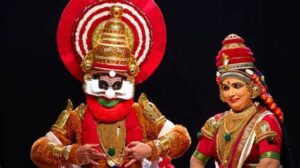
Jatra Indian Folk theatre Art
It is an open-air presentation. Initiated by the Vaishnava saint Chaitanya Mahaprabhu, he used the medium of travel to spread the teachings of Lord Krishna. Adaptations of the Rama Yatra, Shiv Yatra and Chandi Jatra also came into existence, including mythological Stories taken from narratives are told.
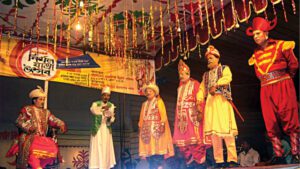
In modern times, Jatra is used to narrate stories with secular historical and patriotic central hairs. Shahi Yatra is a popular Mohalla theatre art prevalent in Odisha.
Kariyala Indian Folk theatre Art
This is the free sky Another form of theatre art that is popular in the Terai regions of Himachal Pradesh, staged at the time of rural fairs and festivals, it is performed at night, it consists of a series of dramas and parahasas.
Manch
This is the folk drama art of Malwa Chitra of Madhya Pradesh, initially based on mythology like Mahabharata and Ramayana, romantic folk tales were honored in its color panel, the unique feature of this genre is its dialogues which are called as couplets called Rangat Doha.
Nautanki Indian Folk theatre Art
Nautanki, a branch of swang, is the most popular drama art of North India, it is discussed in Abul Fazl’s book Ain-e-Akbari. These plays are made around historical, social and folk tales, they are presented through dance or music. The dialogues are presented in the lyric style to the beat of a drum called Nagada, in the later period, two styles of drama based around Kanpur and Lucknow gained prominence.
Ojapali Indian Folk theatre Art
Assam has a unique descriptive theatrical art form. The story telling of the festival, which is initially related to the festival of Mansa Devi or Nag Devi, is a long process which has three different expressions, Baniya Khand, Bhatiali Khand and Dev Khand Ojha are the main narrator and members of Pali with Gaan.
Powd Indian Folk theatre Art
After Shivaji killed his enemy Afzal Khan, a play was composed in praise of Shivaji’s valor, which was later powd. The stories of Soriya are sung by folk musicians known as Gondalas and Shaheer.
Tamasha Indian Folk theatre Art
Tamasha is a folk theatre art of Maharashtra region known for its humour, taste and aphrodisiac expression; its unique feature is the presence of female actresses who also play the role of men.
Bhand pather Indian Folk theatre Art
These are the folk drama art of Jammu and Kashmir, it can also contain contemporary social satire, mythology, it is staged by Muslims. It consists of music, dance and drama.
Bhaona Indian Folk theatre Art
It is a folk theatre art of Assam, especially Majuli Island, aimed at spreading religious and moral messages among the people through entertainment and drama. The Sanghas on Vaishnava are the presentation of the Sutradhar narrating the play and singing verses from the sacred texts.
Dashavatar Indian Folk theatre Art
It is a popular form of plays by farmers of the Konkan region, especially Maharashtra and North Goa, by which the 10 incarnations of Lord Vishnu are honored, it has two parts, Purva Rang and Uttara Rang.
![]()
Bhand Indian Folk theatre Art
This is imitation-based drama in Punjab and Uttar Pradesh, the performer is called a polymorph of artists or imitators, he carries social or political messages, humor, stupidity, witty retorts and use of humour. This is Muslim Bhand, performed by community artists.
Drama Art of South India
When the classical theatrical art began to decline in the 18th century AD in North India, its popularity in South India increased, the dramatic art tradition of South India is characterized by an emphasis on dance, while in the North the emphasis is on music.
SouthSome of the popular dramas of India are as follows:
Villu patu Indian Folk theatre Art
Villu Paatu Geet, which means Sagittarius song, is a form of musical drama popular in parts of Kerala and Tamil Nadu in which stories from the Ramayana are narrated with the help of a bow-shaped instrument.
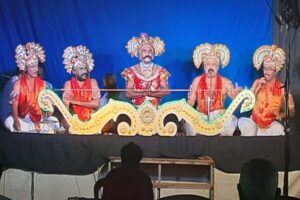
Yakshagana Indian Folk theatre Art
These are: Perhaps the oldest theatre tradition that exists till today in some parts of Karnataka and Kerala, originated in the royal court of the Vijayanagara Empire, performed by a distinguished community called Jagakul Varu. It was a soloist-turned-actor and widely descriptive dance drama. There were further adaptations in the Vidhanavas and it became a special dance drama, it was greatly influenced by the Vaishnava Bhakti movement.
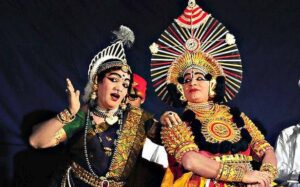
Burra katha Indian Folk theatre Art
It is a popular storytelling tradition of Andhra Pradesh. It is named after the Yantra Burra, a bar widely used during presentations. The presentation consists of a main performer or narrator and two master performers who provide rhythm.
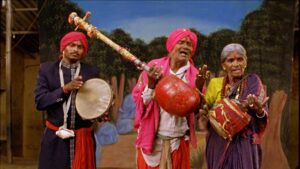
Pagati veshalu Indian Folk theatre Art
The presentation consists of a main performer or narrator and two master performers who provide rhythm.
Modern Indian Folk theatre Art
After the Middle Ages of India, or during the colonial era, modern theatre took shape, translations of both classical texts and classical texts were available, which encouraged theatre, adaptations of the works of Gotthold Price Lens and Shakespeare.
The development of cities like Calcutta and Madras necessitated new forms of entertainment, in the 19th century theatre like Belgachia theatre, Shoba Bazar theatre, etc. emerged in Calcutta, in the British era, Indians developed their own style by combining both western and Indian styles.
Due to which, unlike in the past, the audience now had to pay the price, social evils such as dowry, caste system, religious hypocrisy and political topics were involved. To curb the growing political awareness, the British government introduced the Dramatic Demonstration Act in 1876.
Parsi theatre was very popular in western India in the 1850s to 1920s, plays were also written in regional languages like Gujarati and Marathi, the advent of cinema in the 1930s brought themes like romance, margins, sentimentality, etc. Bengal Maharashtra also gained prominence.
Rabindranath Tagore was a well-known playwright who wrote his first play Valmiki Pratibha at the age of 20. His famous fame included Raktakarbi Chitrangada Post Office. His subjects included nationalism, spiritual, socio-political situations. Other eminent personalities were Persona Kumar Thakur, Girish Chandra Ghosh, Din Bandon Mitra etc.
In 1943, the Indian People’s Theatre Association was formed as the cultural wing of the Communist Party. Disbanded in 1947 it contributed very significantly to the further development of theatre. Prominent personalities associated with the Indian People Theatre Association were Balraj Sahni, Prithviraj Kapoor, Bijan Bhattacharya, Ritwik Ghatak, Utpal Dutt etc.
The Indian Pal People Theatre Association is now active in Chhattisgarh, Punjab and West Bengal. Prithvi Theatre was founded in 1944 by Prithviraj Kapoor. A permanent theatre opened in Mumbai in 1978 and still exists. The Sangeet Natak Akademi was established in 1952 to encourage the performing arts, including theatre.
Conclusion
Indian folk theatre, which combines dance, music, drama, and rituals, is a vibrant representation of the nation’s rich cultural legacy. Through captivating storytelling and performances, it portrays the socio-cultural lives of diverse communities while delivering moral, religious, and social messages.
Folk theater is still relevant today because it preserves traditional stories and strengthens community ties, even in the face of the rise of contemporary entertainment. It is essential for transferring values, history, and folklore from one generation to the next. The art form’s longevity in India’s rich cultural tapestry is guaranteed by its versatility and close ties to regional customs.
Comments
Post a Comment